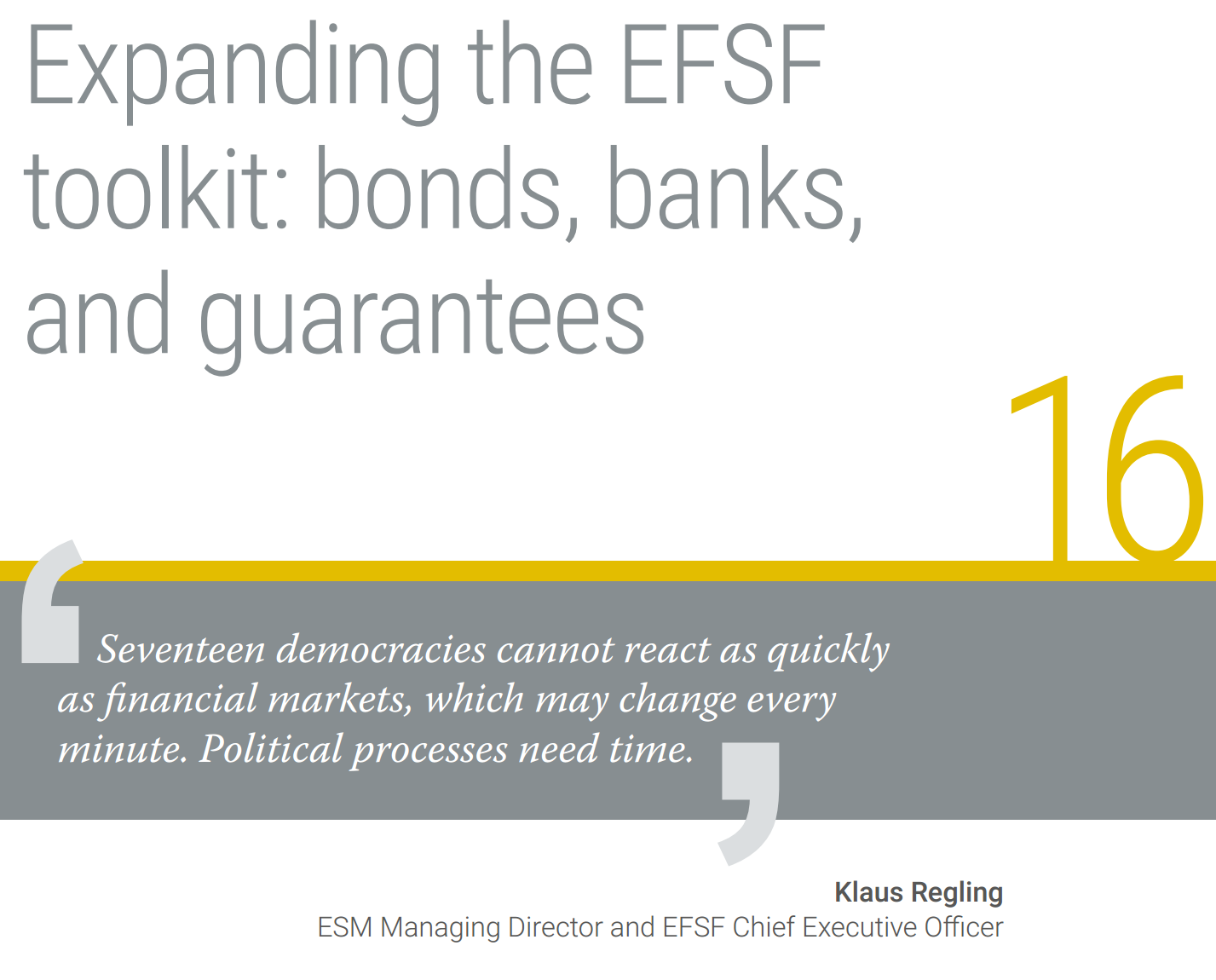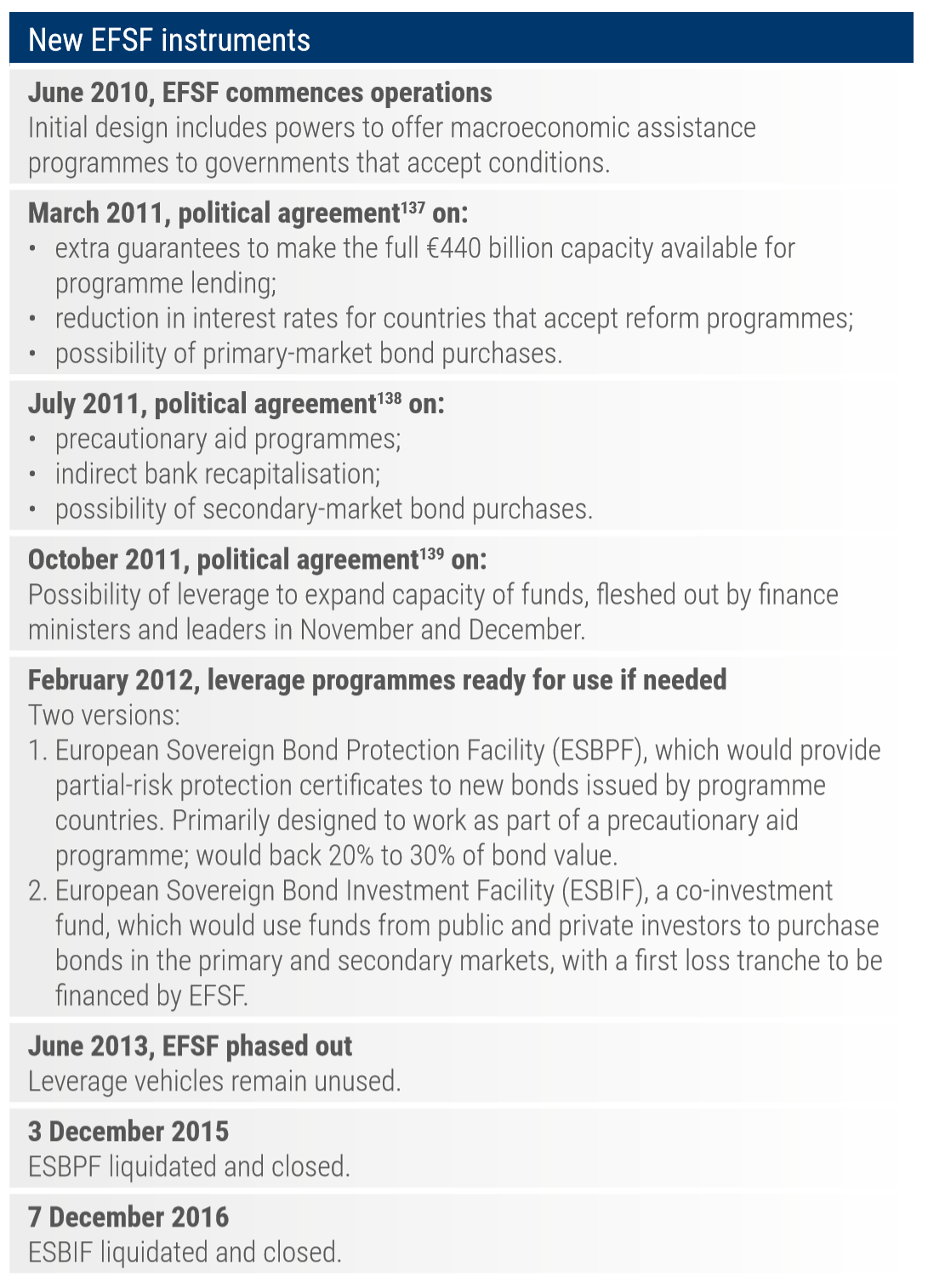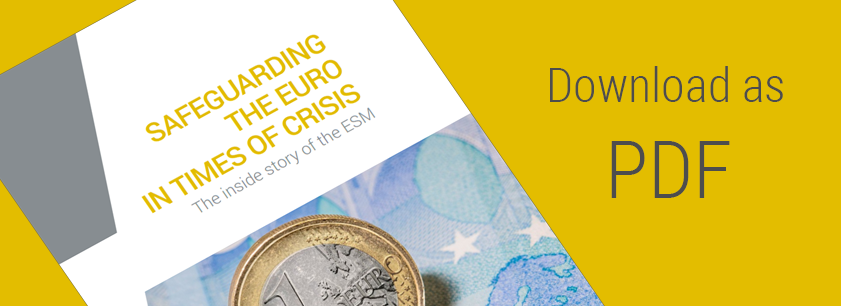16. Expanding the EFSF toolkit: bonds, banks, and guarantees

The 2011 accord to create a permanent mechanism was a breakthrough. Still, the ESM’s scheduled start date was more than two years away. The euro area had to take more immediate action to counter the crisis. At an emergency summit on 11 March 2011, beefing up the EFSF and providing more relief for distressed countries dominated the agenda, a peak in the long debate over the euro area’s rescue capacity.
From the outset, the EFSF’s principal drawback had been its structure of national guarantees. In June 2010, the euro area took an initial step to address the problem that not all the countries providing these guarantees were themselves rated AAA: it raised its backing to 120% of the fund’s capacity. But, even with that buffer, the EFSF could garner a top rating only if it limited its total possible lending envelope to about €250 billion, well below the €440 billion proclaimed in May 2010.
Faced with the inescapable mathematics, the leaders had no choice but to bolster the guarantees a second time. So, at the March 2011 summit, they pledged to make the targeted EFSF lending capacity ‘fully effective’[1] until the ESM took over. In practice, that entailed raising the EFSF guarantees to €780 billion, or 165% of the total, in order to underwrite lending of the full €440 billion. By October 2011 the whole amount was available, minus the funds that by then had been set aside for Ireland and Portugal.
In the virtuous circle of winning market confidence for the euro rescue effort, the 2011 guarantee increase was pivotal. Stronger euro area backing for the rescue fund translated into more market confidence, which in turn allowed the EFSF to borrow under more favourable conditions. Better access to market financing lessened the likelihood of the guarantees ever having to be activated.
Programme countries were the ultimate beneficiaries. Secure access to funding swept aside any doubts about the EFSF’s ability to put together aid packages.
Ultimately, no money would change hands to lift the guarantee levels. Moreover, as long as the programme countries followed through on their economic and budget commitments, the risk that the guarantees would need to be called was low.
For accounting purposes, however, the EU statistical authority, Eurostat, classified the use of the guarantees as debt. As long as the EFSF remained unused, this point was moot. However, as soon as the EFSF started to issue debt to fund programmes, each such issue also upped EFSF shareholders’ debt figures in line with their share of the guarantee given[2].
‘If you look at the EFSF and certain aspects of the EFSF, at how debts of the EFSF were routed to Member States, that is one aspect that perhaps could have been addressed better,’ Malta’s Camilleri said. ‘But, within the context in which we were operating, here was a list of priorities which had to be taken first. Which was the biggest priority? The biggest priority was stabilisation.’
The euro area had already acted to minimise the deleterious statistical impact on aid recipients: in designing the technical specifications for the start-up EFSF, they had added in 2010 a ‘stepping-out mechanism’ that released countries that were receiving aid from the financial responsibility of standing behind the rescue mechanism as a whole. New euro members such as Estonia, Latvia, and Lithuania were also exempt from providing guarantees that predated their full euro membership. Still, the guarantee difficulties showed the EFSF’s limitations and the need for the ESM to take its place as the euro area’s backstop.
In March 2011, however, the EFSF was all that was available. At the emergency summit, leaders also took the first in a series of steps to expand the rescue toolkit, by empowering the EFSF to purchase bonds on primary markets[3]. This tool, which went through several permutations as the rescue funds evolved, was intended to shore up borrowing by countries with partial market access. Buoyed by the EFSF as an additional buyer, bond sales would be less likely to be stymied by insufficient demand. This instrument has not been used, but remains available through the ESM should a country ask for it.
May 2011 brought fresh urgency. On 6 May 2011, finance ministers from Germany, Spain, France, and Italy met with Trichet, then president of the ECB, at a castle in Luxembourg to discuss more aid for Greece and the real prospect of writing down Greek debt and forcing losses on private investors. Trichet was distressed at the time by leaks to the media about a meeting out of the public eye and the presumption that the agenda included Greece’s potential departure from the euro area – particularly since the Deauville deal was still on the table. Trichet, an adamant opponent of normalising sovereign debt writedowns, walked out of the meeting. Nonetheless, the event prompted press reports that Greece might leave the euro.
The international crisis-fighting team was thrown into further turmoil when IMF Managing Director Strauss-Kahn stepped down that same month[4]. In early July, France’s Lagarde was named his successor, around the same time that Italy’s Draghi was chosen to take over from Trichet at the ECB.
Meanwhile, market access was faltering in many corners of the euro area. In mid-May, the EU published debt and deficit forecasts that showed further erosion of the fiscal outlook in Greece and Portugal. On 31 May, Cyprus drew a three-notch downgrade from Fitch, and other markdowns followed. On 5 July, Moody’s cut Portugal’s long-term sovereign debt to below investment grade status[5].
Sobering fiscal numbers, deteriorating credit quality, and waning confidence in Greece’s turnaround combined to unnerve financial markets. It was clear that part of the original strategy – elevated interest rates on official loans to deter other would-be borrowers – was not having the intended effect.
Euro area leaders rebooted the crisis-fighting strategy at another hastily arranged summit, in July 2011. Relief for programme countries, in the form of lower rates and longer loans, was accompanied by a decision to further expand the rescue toolkit. The EFSF and, later, the ESM were equipped with three new instruments: secondary-market bond buying, precautionary aid programmes, and indirect bank recapitalisation in order to help countries reinforce their financial sectors without a full-scale macroeconomic adjustment programme.
The secondary market purchases, which so far have never been used, would take advantage of the firewall’s influence in the market in a completely different way from its usual activities. For the ESM’s day-to-day investment operations, the opposite effect is required: the objective is to buy and sell sovereign bonds and other securities without a noticeable impact on market pricing. But if the euro area were to authorise sovereign bond purchases – possibly alongside a precautionary or full economic adjustment programme – the ESM would design its purchases specifically to support market prices for bonds of the programme country, provided all necessary conditions were met.
Rescue fund purchases of bonds on the secondary market could take place only ‘on the basis of an ECB analysis recognising the existence of exceptional financial market circumstances and risks to financial stability’[6], and only by mutual agreement of all the euro area member states, the summit statement said. Precautionary programmes were designed to support a country’s market access and thereby pre-empt a larger crisis by allowing a country to seek help at an early stage and benefit from less strict conditions.
Some of the inspiration for the new firewall tools came from the IMF. Lagarde said the IMF has had positive experiences with countries that took up its precautionary credit lines, and such instruments ‘can be extremely helpful.’ Just as no country has sought a bond-buying programme, the ESM has yet to use the precautionary instrument. ‘There are countries that would do well with a precautionary line, but they are a bit concerned about being associated with it,’ she said.
One euro area resource, however, is without an IMF equivalent: the banks-only programme that provides loans for countries to recapitalise banks without requiring a full macroeconomic programme. It is known as indirect bank aid because the funds are channelled through the national government. It has been used successfully in Spain, where it was granted under the EFSF and then transferred to the ESM by the time funds were disbursed. Later on, once the ESM was in place and the EFSF had ceased offering new programmes, the euro area would consider whether or not to provide direct bank aid and remove the national government from the financial equation, but back in 2011 there was no such instrument.
The summit deal was essential to secure central bank support for the by now inevitable impending writedown of Greece’s privately held debt. Trichet had been pushing back against the idea because he didn’t want the euro area to set a precedent that could spook markets, but the July talks persuaded him to adjust his stance.
The former ECB chief said he thought it would at some point be necessary to engage in debt alleviation for Greece. However, as long as the Deauville agreement was in the air, any such event would be interpreted by market participants as the first in a sequence that could touch all vulnerable countries in the euro area, risking its dismantling. It needed to be clear that taking action regarding Greece would not lead to similar fates for other euro countries. Trichet said this reasoning led him to assent, on behalf of the ECB, in July 2011 to debt writedowns for Greece, as long as the euro area agreed to certain conditions.
Specifically, he wanted assurances that the ECB would not be hurt by the event; that the governments would affirm solemnly that all other countries would honour their obligations, in effect cancelling the Deauville agreement; and that the governments accepted that they could intervene themselves on the secondary market of public debts. The goal was ring-fencing all other euro countries from Greece-related contagion. When the EU leaders released their July 2011 statement, the key paragraph for Trichet was this: ‘As far as our general approach to private sector involvement in the euro area is concerned, we would like to make it clear that Greece requires an exceptional and unique solution’[7].
Trichet said the euro area also benefited from its July commitment to bolster the EFSF and ESM with new tools, particularly by giving the firewalls the power to intervene on secondary bond markets under exceptional circumstances. This was an ‘extremely important decision’ that gave the euro area more tools to address contagion, he said.
Focus
Bond-buying power
Early in the EFSF’s existence, the euro area decided it should have the power to buy bonds on primary or secondary markets, if requested by a euro area member state in danger of losing market access. These tools could be used to help the country raise liquidity and support the demand for its bonds. Any such programme would first need to be requested by the beneficiary and approved by the Eurogroup, along with the necessary conditions. But then it would need to be executed.
Primary-market purchases would be carried out by the EFSF’s funding team, with its substantial experience in bond offerings. Secondary-market purchases might be trickier, especially in the EFSF’s early days, when there was not yet an established investment department.
The Bank of France and the ECB decided to help. The EFSF developed a governance system and communications platform for collaborating with the two central banks. ‘Very quickly the capacity of the EFSF was put in place. Everything was ready at a very early stage – but it’s never been used,’ said Sébastien Lévy, a former Bank of France staffer who is now the ESM’s head of investment and treasury.
The ESM now has two bond-buying instruments at its disposal that countries may request: primary-market purchases, intended to help countries continue to sell bonds directly to investors, and secondary-market purchases, which can be used to aid liquidity on capital markets.
With the ESM’s establishment, the ECB withdrew and focused on its own bond-buying programmes. The ESM took over all EFSF activities. But the Bank of France has remained on call as a service provider for both the EFSF and now the ESM. Should a secondary-market purchasing programme ever take place, the ESM’s investment division would be at the helm of the operation, but trades could be carried out in either Luxembourg or Paris. This gives the ESM more flexibility, and also more avenues for carrying out its purchases.
In August 2011, Spain and Italy became the targets of market speculators, amid warnings from private sector analysts that their market access was under threat[8]. Trichet said he turned to the July framework as the basis for a series of actions to push back against the financial contagion. First, he asked the euro area governments – particularly Germany and France – to confirm their July commitments. He also wrote on behalf of the ECB to the prime ministers of Spain and Italy, ‘to draw their attention to the necessity of regaining creditworthiness through effective and visible measures’. Against this backdrop, the ECB was ready to act.
The ECB sought to protect its monetary transmission mechanism, by patching up dysfunctional segments of bond markets. On 4 August, the ECB voted to resume its own bond-buying programme, which it had started in 2010 during the euro area’s first efforts to build a coordinated crisis response[9]. Three days later, the ECB held an emergency conference call and signalled it would begin purchasing Italian and Spanish bonds as part of its Securities Markets Programme[10]. The impact was immediate: the next day, Spain’s 10-year yield fell 88 basis points to 5.16% and Italy’s sank 80 basis points to 5.28% on Monday 8 August.
But that respite proved short-lived. There was a perception that contagion was beginning to spread. In the month of October alone, Spain and Italy were hit by a wave of downgrades attributed to political uncertainty, weak growth, and the ongoing crisis. Standard & Poor’s downgraded Cyprus and Slovenia.

Continue reading
[1] Conclusions of the Heads of State or Government of the euro area of 11 March 2011, 11 March 2011. https://www.consilium.europa.eu/media/21423/20110311-conclusions-of-the-heads-of-state-or-government-of-the-euro-area-of-11-march-2011-en.pdf
[2] Eurostat (2011), ‘New decision of Eurostat on deficit and debt. The statistical recording of operations undertaken by the European Financial Stability Facility’, Press release, 27 January 2011. https://ec.europa.eu/eurostat/documents/2995521/5034386/2-27012011-AP-EN.PDF
[3] Conclusions of the Heads of State or Government of the euro area of 11 March 2011, 11 March 2011. http://www.consilium.europa.eu/media/21423/20110311-conclusions-of-the-heads-of-state-or-government-of-the-euro-area-of-11-march-2011-en.pdf
[4] IMF (2011), ‘IMF Managing Director Dominique Strauss-Kahn resigns’, Press release, 18 May 2011. http://www.imf.org/en/News/Articles/2015/09/14/01/49/pr11187; Financial Times (2011), ‘Strauss-Kahn resigns as head of IMF’, 19 May 2011. https://www.ft.com/content/ab0bdf0a-81ce-11e0-8a54-00144feabdc0
[5] For further discussion of the factors that influence sovereign ratings, see D’Agostino, A. and Lennkh, R.A. (2016), ‘Euro area sovereign ratings: An analysis of fundamental criteria and subjective judgement’, ESM Working Papers 14, 12 May 2016. https://www.esm.europa.eu/publications/euro-area-sovereign-ratings-analysis-fundamental-criteria-and-subjective-judgement
[6] Statement by the Heads of State or Government of the euro area and EU institutions, 21 July 2011. https://www.consilium.europa.eu/media/21426/20110721-statement-by-the-heads-of-state-or-government-of-the-euro-area-and-eu-institutions-en.pdf
[7] Ibid.
[8] New York Times (2011), ‘Worries rise over Spain and Italy debt’, 2 August 2011. https://www.nytimes.com/2011/08/03/business/global/pressure-builds-on-italy-and-spain-over-finances.html
[9] ECB (2011), ‘Introductory statement to the press conference (with Q&A)’, Transcript, 4 August 2011. https://www.ecb.europa.eu/press/pressconf/2011/html/is110804.en.html
[10] ECB (2011), ‘Statement by the president of the ECB’, Press release, 7 August 2011. http://www.ecb.europa.eu/press/pr/date/2011/html/pr110807.en.html
[11] Conclusions of the Heads of State or Government of the euro area of 11 March 2011, 11 March 2011. http://www.consilium.europa.eu/media/21423/20110311-conclusions-of-the-heads-of-state-or- government-of-the-euro-area-of-11-march-2011-en.pdf
[12] Statement by the Heads of State or Government of the euro area and EU institutions, p. 3, 21 July 2011. https://www.consilium.europa.eu/media/21426/20110721-statement-by-the-heads-of-state-or- government-of-the-euro-area-and-eu-institutions-en.pdf
[13] Euro summit statement, p. 6, 26 October 2011. https://www.consilium.europa.eu/uedocs/cms_data/docs/pressdata/en/ec/125644.pdf ; Statement by the euro area Heads of State or Government, p. 5, 9 December 2011. https://www.consilium.europa.eu/uedocs/cms_data/docs/pressdata/en/ec/126658.pdf


